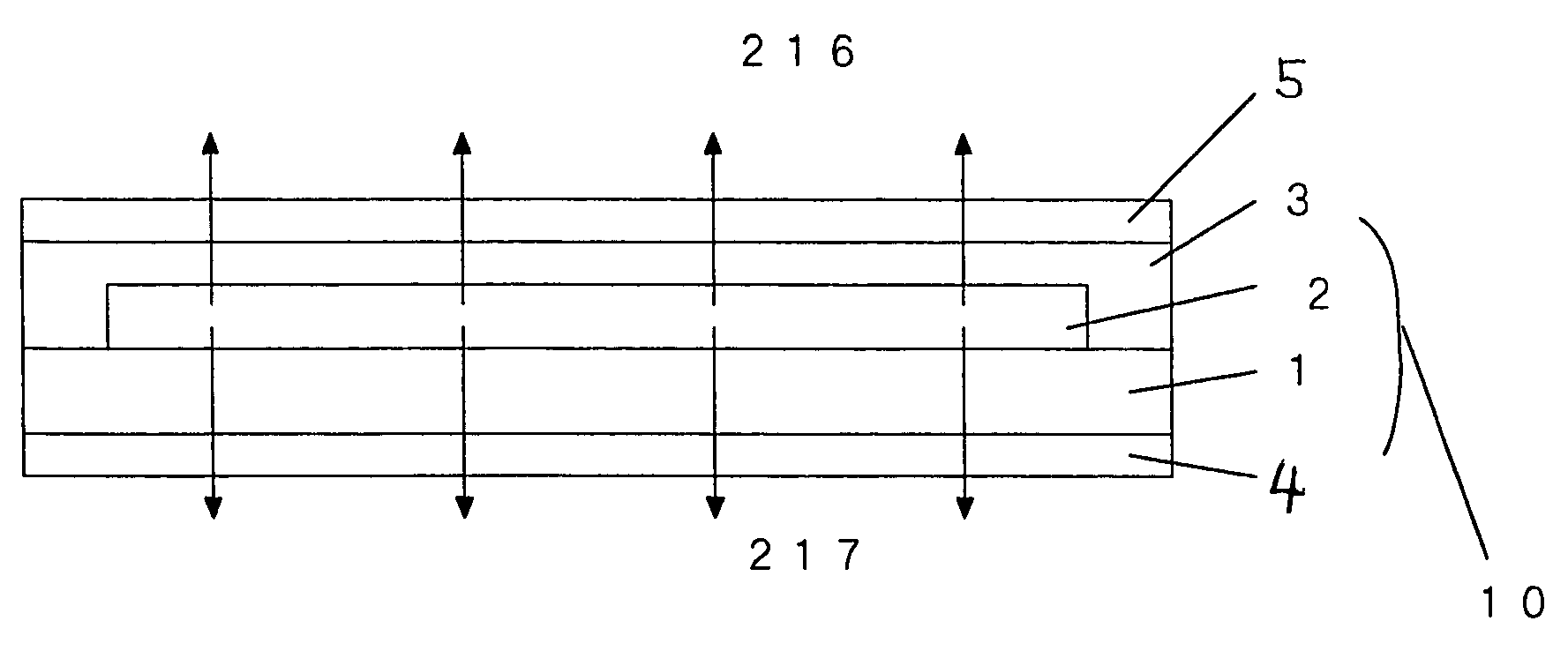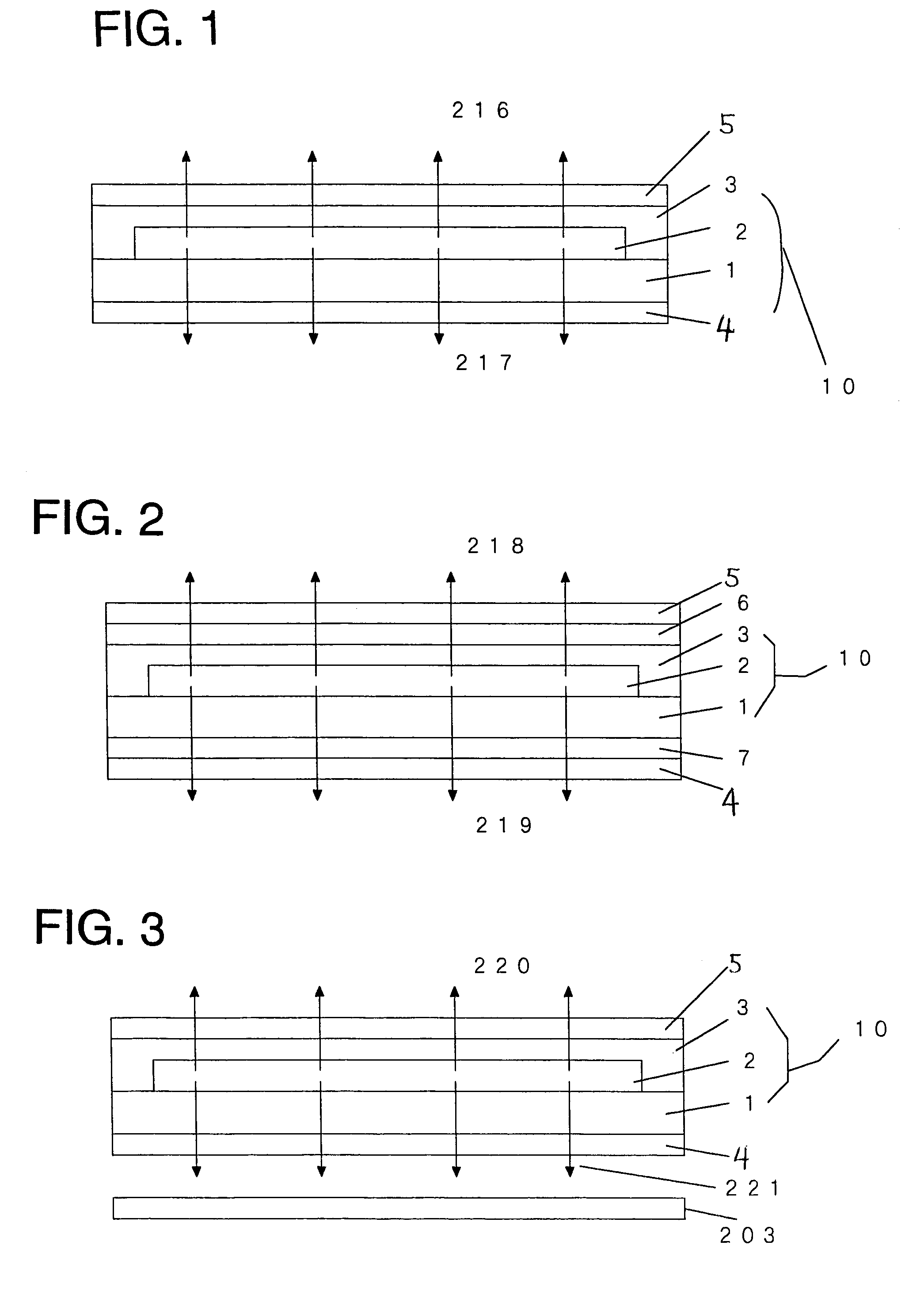Self light emitting display device
- Summary
- Abstract
- Description
- Claims
- Application Information
AI Technical Summary
Benefits of technology
Problems solved by technology
Method used
Image
Examples
embodiment 1
(Embodiment 1)
[0041]FIG. 1 is a schematic sectional view showing an organic EL device of this embodiment. As shown in FIG. 1, an organic EL element portion 2 is formed on the surface of a substrate 1. The organic EL element portion 2 is sealed with a sealing structure 3, thereby composing an organic EL cell 10. A first polarization layer 4 and a second polarization layer 5 are disposed at both ends of the organic EL cell such that transmission axes thereof are orthogonal to each other.
[0042]A display principle of an organic EL device having such a structure will be described with reference to FIG. 10. The first polarization layer 4 and the second polarization layer 5 are disposed at both sides of the organic EL cell 10. A transmission axis L7 of the first polarization layer 4 is orthogonal to a transmission axis L6 of the second polarization layer 5. EL light 121 emitted from a light emitting portion 101 of the organic EL cell 10 transmits through the second polarization layer 5 hav...
embodiment 2
(Embodiment 2)
[0049]FIG. 2 is a schematic view showing a sectional structure of an organic EL device according to Embodiment 2. Note that the description of the organic EL cell 10 overlapped with Embodiment 1 is omitted here as appropriate. As shown in FIG. 2, the organic EL device includes a first polarization layer 4 and a second polarization layer 5 which sandwich therebetween the organic EL cell 10; a first optical phase differential layer 7 (retardation: Än1d1, where Än is optical anisotropy and d is a thickness) provided between the organic EL cell 10 and the first polarization layer 4; and a second optical phase differential layer 6 (retardation: Än2d2) provided between the organic EL cell 10 and the second polarization layer 5. A transmission axis of the first polarization layer 4 is parallel to a transmission axis of the second polarization layer 5, a delay phase axis of the optical anisotropy of the first optical phase differential layer 7 (Än1d1) is parallel to a delay ph...
embodiment 3
(Embodiment 3)
[0057]FIG. 3 is a schematic sectional view of an organic EL device of this embodiment. Note that the descriptions overlapped with above-mentioned respective embodiments are omitted here as appropriate. As shown in FIG. 3, the first polarization layer 4 and the second polarization layer 5 are disposed in both sides of the organic EL cell 10 such that transmission axes thereof are orthogonal to each other. In this embodiment, a polarizing plate is used for the polarization layers. Further, a privacy device in the form of a shutter 203 is located outside the first polarization layer 4 so as to correspond to a light emitting region of the organic EL cell 10. The case where the organic EL device shown in FIG. 3 is applied to a foldable information device having two foldable connected sections as shown in FIGS. 12 and 13 will be described as an example. In a state in which the information device is folded and the two sections overlap (FIG. 12), the shutter 203 is opened. The...
PUM
 Login to View More
Login to View More Abstract
Description
Claims
Application Information
 Login to View More
Login to View More - R&D
- Intellectual Property
- Life Sciences
- Materials
- Tech Scout
- Unparalleled Data Quality
- Higher Quality Content
- 60% Fewer Hallucinations
Browse by: Latest US Patents, China's latest patents, Technical Efficacy Thesaurus, Application Domain, Technology Topic, Popular Technical Reports.
© 2025 PatSnap. All rights reserved.Legal|Privacy policy|Modern Slavery Act Transparency Statement|Sitemap|About US| Contact US: help@patsnap.com



